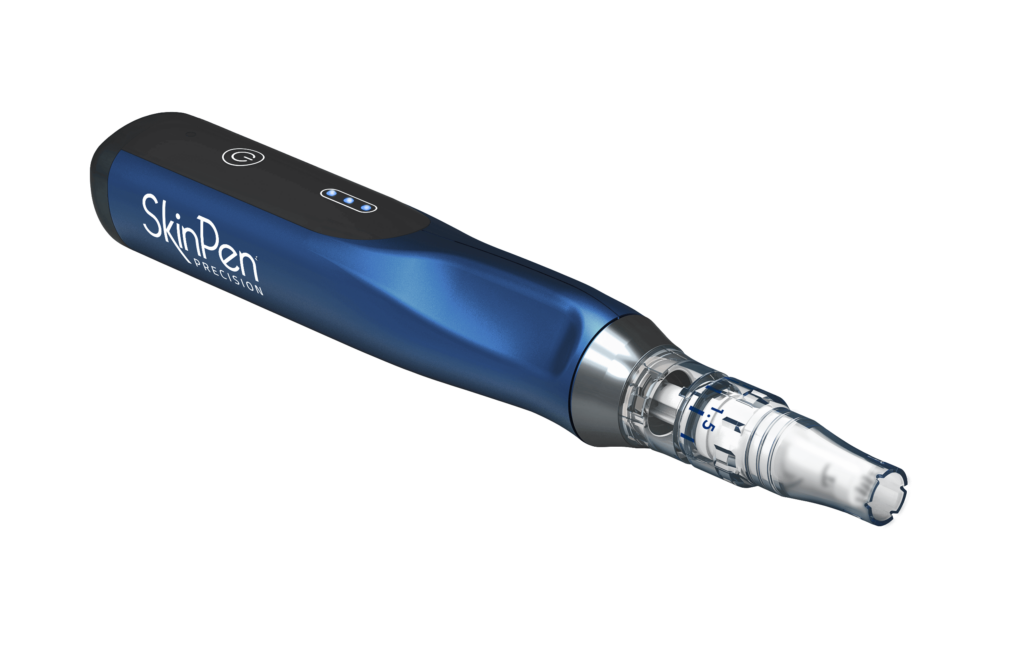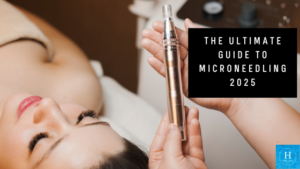
What is Microneedling?
Microneedling, also known as Collagen Induction Therapy is a medical aesthetic procedure that uses very small needles to repeatedly penetrate layers of the skin in order to create a wound healing cascade.
This results in microscopic holes or microchannels in the dermis.
This treatment improves the appearance of acne scars, fine lines and wrinkles, hyperpigmentation, skin tone and texture.
History of Microneedling:
In the 1950’s mesotherapy was discovered by Dr. Michel Pistor. He used a meso device with one needle.
He came up with the concept that pricking the skin would promote collagen formation.
Then in 1995, subcision came around which was a new method of treating depressed scars and wrinkles.
Following subcision, came needle dermabrasion in 1997.
This treatment involved using a tattoo pistol to treat scars.
Patients saw improvement in scar texture, appearance and color, however this treatment was very time and labor intensive due to use of only one needle.
In 1998, Dr. Des Fernandes from South Africa developed a small needling stamping device and presented his study on needling at a conference in San Francisco.
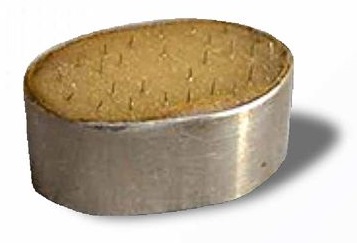
By the year 2000, the first medical Microneedling device called the Dermaroller was invented by Horst Liebl.
This device consisted of many fine needles on a drum shaped roller.
By the mid-2000’s, Microneedling grew popular in medical offices, medspas, and with patients.
In 2018, the SkinPen Microneedling device was FDA cleared to improve the appearance of acne scars of adults 22 years of age and older.
It was designed for use by licensed healthcare practitioners or individuals directed by practitioners.
The science behind the Microneedling treatment
The skin goes through three phases of wound healing.
First the skin is injured which causes inflammation and releases growth factors.
Then the tissue goes into the proliferation phase where the fibroblasts release growth factors, glycoproteins, and collagen causing the epidermal cells to migrate to the wound.
Then tissue and capillaries form, and fibroblasts continue to proliferate.
In this phase, the dermal thickness increases.
In the last phase of microneedling wound healing, the tissue is remodeled which causes a skin tightening effect by promoting fresh new collagen.
Complete tissue remodeling can take place from 3 weeks to 1 year.
Most remodeling completes after 6 months.
A study by Fernandes, D. Oral showed 400% more collagen was produced after 6 months following a Microneedling treatment.
Microneedling for Wrinkles & Acne Scars
As we age, our skin thins and our epidermal layer of skin thickness decreases.
One study showed that the thickness of collagen in a 2 year old dermis is about 1.37 um vs. the thickness of collagen in a 90 year old has an average of .52 um.
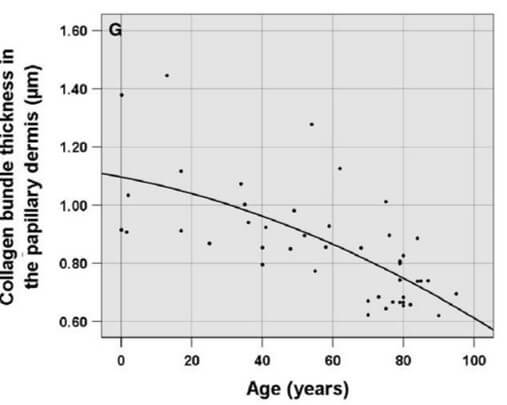
The collagen loss surrounding the scar creates a cave like and shadowing appearance
When combining the effects of aging skin with uneven acne scars, the result is a more prominent appearance of acne scars.
With Microneedling, the wound healing process creates collagen and increases the thickness of the dermis to create a more a youthful appearance as well as helps to repair acne scars.
To reduce the appearance of acne scars in adults and improve the appearance of surrounding skin, you must treat both effectively.
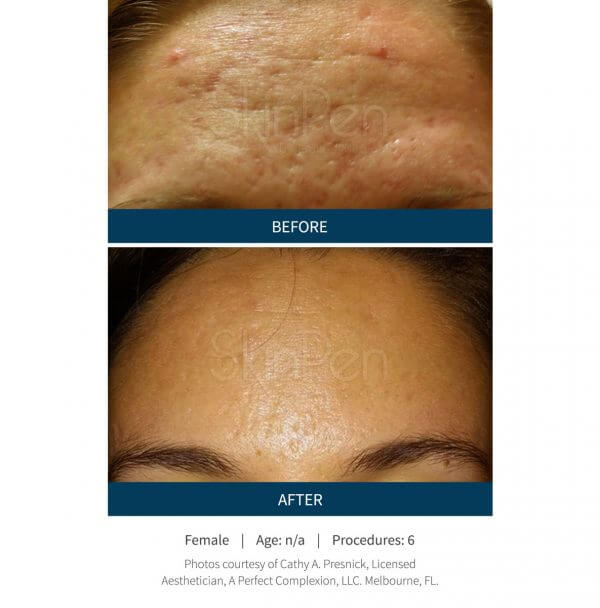
Frequently Asked Treatment Questions:
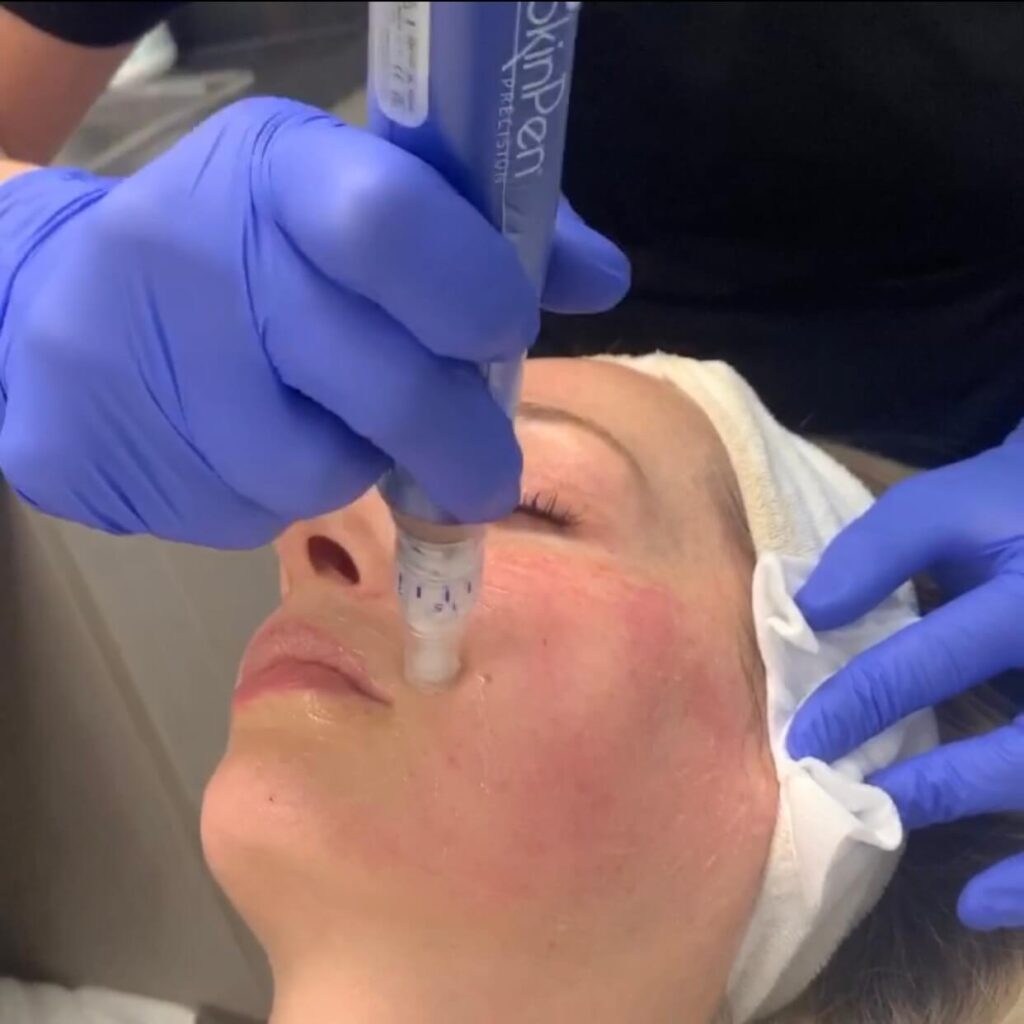
What is the best and safest medical grade Microneedling device?
The SkinPen is the only FDA cleared and legally marketed automated, non-surgical Microneedling device on the market. It is proven safe and effective to treat and improve the appearance of acne scars in adults aged 22 and older.
What are some side effects of Microneedling?
Dryness, rough skin, tightness, redness, itching, peeling, discomfort, tenderness and burning are some of the side effects that some patients have seen last from 1 to 6 days post Microneedling.
How will my skin look after Microneedling?
Your skin may have an appearance of a mild sunburn to moderate sunburn.
What are the contraindications for Microneedling or reason why someone should not receive a Microneedling treatment?
Patients who have the following should not receive Microneedling:
– Have active skin cancer in the treatment area
– Have open wounds, sore, or irritated skin in the treatment area
– Have an allergy to stainless steel or anesthetic
– Have a hemorrhagic bleeding disorder or a hemostatic bleeding dysfunction.
– Are pregnant or nursing
– Are currently taking drugs with ingredients of isotretinoin such as Accutane.
What areas can not be Microneedled?
Microneedling should not be done around the orbital rim such as the eye lids.
How should I prepare for a Microneedling treatment?
Avoid excessive sun exposure. No sunburn.
Discontinue to use topical retinoids 24 hours prior to Microneedling.
Avoid treatment if you have active breakouts or open lesions.
Allow 24 hours after auto immune therapy.
Wait at least 6 months before oral isotretinoin use.
What to avoid after Microneedling?
You should avoid sweaty exercise and sun exposure 72 hours post your Microneedling treatment.
In addition, you should avoid other facial treatments for a month after Microneedling.
Which products should I use post Microneedling?
You should use Vitamin C as it is a great antioxidant and helps with rebuilding collagen. Vitamin A is also recommended to use after Microneedling as it promotes cell turnover, decreases collagen degradation, and helps to thicken the dermal layer. Also, copper with peptides as it plays a role in the production of collagen and elastin that the body is not able to produce by itself.
Other products that would benefit are Magnesium, as it is a great atioxidant, Zinc because it helps to reduce inflammation and promotes collagen production, and Ginger Extact because it prevents further damage to the skin caused by UV exposure.
Why are good skin care products so important to use after Microneedling?
They can help reduce inflammation, provide moisture, aid in wound healing, improve and maintain aesthetic procedure outcomes, and reduce the risk of potential complications.
Which products or ingredients should I avoid using after Microneedling?
Ingredients known to increase inflammation should be avoided as well as those that hinder the skin’s ability to repair and remodel.
These include:
– Formaldehyde releasing preservatives
– Silicone/Methicone/Dimethicone
– Dyes
– Fragrances
– Petroleum
– Glycol
– Sulphates
– Mineral Oil
– Parabens
– Citrus derived preservatives
It is best to follow the post treatment instructions and products recommended to you by your medical aesthetic provider.
What is the difference between a Dermaroller and a Microneedling pen?
A Dermaroller is an over the counter needling device and Microneedling pen is a medical aesthetic device only allowed to be used in medical aesthetic practices.
What is better Dermarolling or Microneedling?
Mechanical microneedling with an FDA cleared Microneedling device such as the SkinPen produces more microchannels with one pass than created by a Dermaroller with many passes.
How long does it take for the micro-channels created during Microneedling to close after treatment?
One study showed that microchannels created during Microneedling close after 24 hours.
How deep into the skin does Microneedling penetrate?
The SkinPen microneedling device is able to go up to 2.5 mm which is the highest depth of penetration that is proven safe for patients.
If you are looking for Microneedling near me and live in the Bucks County, PA area, call (267) 388-4692 or contact Healthy Solutions Medspa today for a free consultation.
If you enjoyed reading this, share it!
You may also like reading some of our previous blog posts below.

Regain Your Energy and Confidence with Testosterone Replacement Therapy
What Is Testosterone Replacement Therapy? Testosterone replacement therapy (TRT) is a treatment designed to restore healthy testosterone levels in men experiencing symptoms of hormonal imbalance

Introducing EZ Gel at Healthy Solutions MedSpa: Your Natural Path to Rejuvenation
At Healthy Solutions MedSpa, we’re always committed to bringing you the latest in medical aesthetics backed by science and results. That’s why we’re excited to

Why Clear + Brilliant Is Great for the Summer
Do you hate the look of fine lines and large pores? Do you want to improve texture as well as the tone of your skin?

Father’s Day Medspa Gift Guide 2025
Father’s Day is just around the corner, and while traditional gifts like ties, golf gear, and BBQ tools are always appreciated, this year, why not

Testosterone Therapy at Healthy Solutions Medspa
What Is Testosterone Therapy? Testosterone therapy is a medically supervised treatment designed to restore low testosterone levels. This hormone plays a vital role in regulating
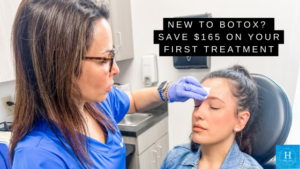
New To Botox? Save $165 Off Your First Treatment
If you’ve been curious about trying Botox but haven’t taken the plunge yet, you’re not alone! Many first-time clients are surprised to learn just how

